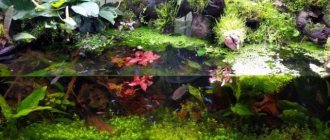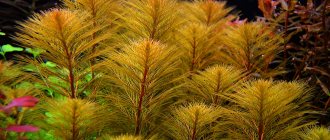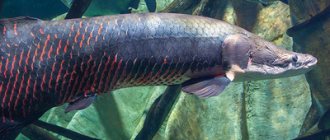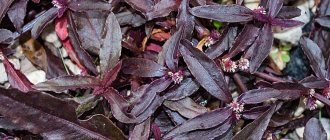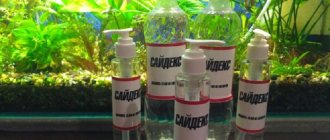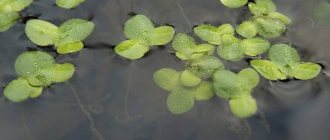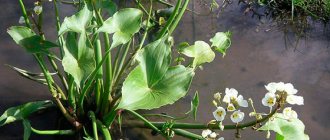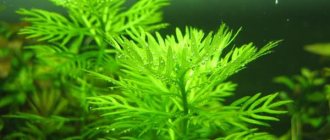Salvinia natans is a species of fern that floats on the surface of bodies of water. This is the only type of salvinia found in Russia. The fern is widespread in the waters of Africa, tropical areas of Asia, as well as in the southern and central regions of Europe. There it grows in bodies of water with standing or slow-flowing water. Salvinia floating decorate aquariums and ponds.
Botanical description and taxonomy
Salvínia is a free-floating perennial aquatic fern consisting of pairs of green to brown oval leaves connected by a horizontal stem.
— Advertising —
At the top of each leaf there are many tiny, hair-like structures that split and then join at the ends to form an egg-like structure. Underwater, each individual produces other leaves, which look like a small tuft of brown roots. The stems are thin and highly branched, up to 30 centimeters in length, from one to two millimeters in diameter. The length of leaf nodes varies inversely with fern density. Leaves grow in two types: submerged and floating. Immersed brown in color, deeply divided into a group of unbranched root-like filaments 2-25 centimeters long. The floating leaves are green, almost round, two-lobed, with a smooth edge. The upper surface is covered with rows of waxy, ovoid hairs one millimeter long.
Individuals have no roots. It is believed that the hair-like structures found on the submerged thread-like leaves are a replacement for the rhizome and help in the absorption of water and nutrients. These hairs differ from roots in that they are multicellular.
Feeding
First of all, you need to remember that this is a predator and live food will be the first delicacy. For example, frozen bloodworms, coretra or tubifex. To prevent and maintain excellent health, cichlazoma Salvini can and should be given food of plant origin, as well as special food in the form of dried seafood, earthworms, granules or flakes. It’s great if you have the opportunity to pamper yourself with small live fish.
A balanced diet is considered to be food that contains ¾ protein and ¼ vegetable fats. Also, Salvini's cichlizoma will not mind eating home-made minced meat, consisting of:
- poultry meat
- herbal supplements
- seafood
Primary habitat
— Advertising —
Salvínia grows best in still or slow-moving fresh water.
Salvinia plants also thrive in nutrient waters, such as waste water.
The botanical description indicates that the algae comes from southeastern Brazil. It has become an invasive species in Africa, India, Sri Lanka, Southeast Asia, the Philippines, Papua New Guinea, New Zealand, Fiji, Hawaii and parts of the United States.
Distribution area
The plant grows in large quantities in southern Africa. You can find ferns in tropical zones, in the southern part of the European continent. Some varieties are native to temperate Asia. The fern is found in India, the central regions of America and Africa, Mexico and North America.
In Russia, fern varieties in their natural habitat can only be found in the southern part of the country. Some species grow in the Volga, Kuban and Don river basins. In the northern regions, the plant is not able to survive in its natural environment. The Far East also has some habitats for this fern.
Plant species
Eared
Salvinia auriculata or eared salvinia is a free-floating fern up to 20 centimeters long. The horizontal rhizome lies below the surface of the water. The leaves come in two types: floating and submerged, light green to gray-green in color, with brownish edges and a characteristic fold in the center. The floating leaves are oval-shaped, up to 2.5 centimeters long and 3.5 centimeters wide. The upper surface contains even rows of papillae, each with a tuft of hairs at the distal end, joined together at the ends into a shape similar to an egg corolla. The cellular structure of the terminal hairs gives the algae buoyancy.
Salvinia eared is widespread in ponds, pools and lakes throughout the Philippines and is native to South America.
The leaves contain proteins, nutrients, lignin, ash and tannins. Phytochemical screening showed the presence of alkaloids, flavonoids, phenols, tannins and saponins. The three main compounds of the leaflets are stigmasterone, stigmasterol and fridelinol.
Scientific research has proven the antimicrobial, phytoremediation (that is, the ability to purify water), biosorbent, and antioxidant properties of this fern.
Klobuchkovaya
Salvinia cucullata is a free-floating fern that develops from a somewhat zigzag horizontal stem (rhizome) that floats just below the surface of the water. The rhizome has opposite pairs of rectangular floating leaves and a third submerged filamentous leaf along each node. Almost all parts of Salvinia, with the exception of the upper surface of the leaf, are sparsely covered with chestnut-colored hairs. Country of origin: Southeast Asia.
floating
Salvinia natans, floating moss or fern, water butterfly are the names of this beautiful aquarium plant. This type of fern is excellent for providing shade over large areas of ponds. It provides both cover for small fish and a natural filter from sunlight.
Salvinia natans is a very recognizable species. Like a typical fern, it has feathery leaves that are arranged horizontally.
The leaves reach about 1.5 centimeters in length. At the base of the kelp grow two large leaves that lie on the surface of the water to keep the fern afloat. These leaves grow up to 2 centimeters in diameter. They are usually light green in color and have a protective layer called cuticular papillae.
The cuticular papillae are a unique layer of skin with hair follicles that prevent algae from rotting due to excessive exposure to water. This allows the algae to continue photosynthesizing while wet and also to withstand strong light.
The ability to tolerate direct sunlight is a rare feature of ferns. This makes Salvinia natans a popular choice for garden ponds and ponds.
Another distinctive aspect of Salvinia natans is its root structure. Instead of long, growing roots like most aquatic plants, it has just one leaf that points down into the water. Although, you can often see some root-like green threads hanging along the leaves. Not only is this a good way to identify moss, but it is also ideal for shallow ponds.
Azolla caroliniana or water fern
The length of the stem is 0.7-2.5 cm. The stem is horizontal, branched, and spreads along the surface of the water. Leaves are opposite, scaly. Sheet width 1 cm. Height 1-2 cm. Total width 5-10 cm or more. The leaf color is green with a colorless edge, turning brown in autumn. The plant is very brittle and delicate, it is easy to damage. Quite unpretentious. T 20-28°C. It tolerates weather changes in the aquarium well. But at a critical temperature of 16°C, the plant freezes and its growth stops. If no action is taken, it will gradually begin to rot. The stem along with all the leaves falls to the bottom. Azolla carolina spores from them can produce another Azolla “offspring” after some time (mainly in the spring). It does not tolerate dirty, stagnant water, so weekly water changes in the aquarium are mandatory. The water environment should not be harsh. pH level up to 7.0 (preferably less than this norm). In order for the leaves and stem to develop and grow well, bright light is needed for 12 hours. If there is too much azolla, it can be removed and left as long as necessary. In winter, when the light changes, azolla plants may die, but if you maintain stability in its content, then this outcome does not threaten. To preserve azolla, you can also resort to another method: take a quantity of azolla and place it in a vessel with damp moss. It needs to be kept in fairly cool conditions (no more than 12°C), and when April comes, it can be returned to the aquarium again.
What are the benefits for an aquarium?
Salvinia, as an aquarium plant, can bring quite a lot of benefits. Let's take a closer look.
Shadow
Adding Salvinia to your aquarium will provide shade for the fish as well as other plants located at the bottom of the aquarium in the substrate. Fish will definitely appreciate a little shade during the day from bright aquarium lights. The lower plants should also be slightly shaded, but care must be taken not to add too much of the species because the lower algae may suffer from lack of light.
Cleaning
The species provide a biological and chemical filtration process much like what your mechanical water filter does. Salvinia eat fish waste and then create good bacteria that helps keep the water clean and clear. Of course, this algae cannot be used as the only filtration process, but it will definitely help your filter last longer.
Protection
Fish like places where they can play and swim in schools. They may also sometimes need a place to hide and feel protected. This is especially true for small fish and fry.
Regardless of the reason, you will notice that your fish will appreciate the presence of the Salvinia genus and will continue to return to it.
Oxygen
Planting Salvinia in an aquarium is a great way to add oxygen to the water.
Plants operate on the principle of an aeration system, like ordinary vegetation in nature. This provides additional oxygen which will benefit the fish in the long run. High O2 levels in the aquarium also help control toxins.
Great view
Salvinias are very interesting and will add a great design touch to your aquarium, even though they don't have flowers. Their presence creates a very natural feeling of greenery and freshness.
Which neighbors will they feel comfortable with?
Having a significant aquarium size, an aquarist can complement a pair of Cichlizoma salvini with worthy neighbors. First of all, these must be individuals of significant size and active lifestyle. Other types of adult cichlids, sacbranch catfish, and possibly mature gouramis would be suitable. A definite “no” to gentle and sensitive natures, as well as to babies like neons and guppies.
Secondly, the image of entertainment should be taken into account. Species of fish that uproot plants and thereby create muddy water will create extreme living conditions for Salvini.
Thirdly, it is better to combine according to the typical habitat in the aquarium. Individuals living in the lower layers of water harmoniously complement cichlases: they clean the aquarium of settled waste and do not interfere with upper feeding.
Cichlosoma salvini is a worthy inhabitant of the home pond. True, for this she needs to understand that she is the main one in the house.
Post Views: 2,385
Reproduction methods
Popular question: does salvinia reproduce by spores or seeds? Salvinia reproduces using sporangia. Let's figure out what sporangium is. In the classical botanical sense, this is a special organ that produces spores in life forms such as plants, fungi and algae. In heterosporous species it produces microspores and is therefore called microsporangium; and when it produces macrospores it is called a megasporangium. Sporangia are united into sporocarps. Details of reproduction have been extensively studied in S. natans. Sporocarps appear in clusters ranging from 4 to 20. Sporocarps usually grow on the inner segments of submerged leaves. They are sympodial in location.
The shape of the sporocarp varies from spherical to ovoid, sometimes flattened and with ribbed surfaces. The sporocarp wall consists of two layers of cells. the young outer layer is covered with hairs.
The life cycle of salvinia, as a spore-bearing plant, is shown in the photo below.
Externally, all sporocarps are similar; they are monosporangiate. The first one or two sporocarps in each cluster are megasporangiate, while all subsequent ones formed are microsporangiate. The sporocarp at its base has a strong columnar rosette that carries a vascular supply to the sporocarp.
After the sporangia mature, the sporocarps detach from the leaves and sink to the bottom of the pond. In annual species, this usually occurs during September, when the plant breaks into pieces. Sporocarps open due to mechanical destruction of their walls. This results in the release of spores. In most cases, spores that float on the surface of the water are still surrounded by sporangial walls.
Breeding Redtail Catfish
Red-tailed catfish fry photo
Breeding Fractocephalus in captivity is so far possible only in fish pond farms, where acceptable conditions can be created for spawning pairs - the volume of a reservoir, for example. In the conditions of aquariums, be it a public demonstration or a “home” two-ton tank, cases of spawning of red-tailed catfish have not yet been recorded. The flathead reaches sexual maturity at about one and a half years, and the sexual differences in young individuals have not been fully studied. All individuals that go on sale in our country are imported from South Asian countries, where red-tailed catfish are bred for gastronomic purposes in fish farms.
All of the above is just the fruit of observing this type of aquarium fish and collecting various information from owners and breeders. We would like to share with visitors not only information, but also live emotions that allow us to understand the world of aquariums more fully and subtly. Register at https://fanfishka.ru/forum/, participate in discussions on the forum, create profile topics where you will talk about your pets in the first person and from the horse’s mouth, describe their habits, behavior and content, and share with us your successes and joys, share your experiences and learn from the experiences of others. We are interested in every bit of your experience, every second of your joy, every awareness of a mistake, which makes it possible for your comrades to avoid the same mistake. The more of us there are, the more pure and transparent drops of goodness there are in the life and everyday life of our seven billion society.
Author Merkulov Ivan
Red-tailed catfish video review
+
Category: Aquarium articles / Aquarium fish | Views: 13,610 | Date: 26-02-2018, 14:45 |
We also recommend reading:
- — Iriaterina Werner
- — Arapaima
- — Indian eyed knife
- - Aquarium store of India!
- — “Autonomous” aquarium at the Indian Delhi airport!
How to properly plant salvinia for aquarium keeping?
Salvinia is one of the easiest algae to grow. The best way to spread at home is to divide the existing mass into separate bunches. Place the bunches on the surface of the water and they will spread themselves quite quickly. Keep them in standing or slow-moving water and bright light to encourage growth. Once acclimated, trim and remove excess pieces.
Use at home
On the territory of a private house, you can set up a garden aquarium - an artificial pond with transparent walls, raised above the ground.
A flowerpot for the street can serve as a support. Salvinia will be very appropriate in such a reservoir: it will create shade for fish and other plants from direct sunlight.
The most unpretentious species is floating salvinia, but other species also feel great in the aquarium under the following conditions:
- constant t◦ of water in the recommended range (from 20 to 30◦C) with a difference in the environment of -5◦C;
- chemical composition: acidity - pH5-8; hardness —dH 4-15◦;
- sufficient illumination (1-3 W/liter), especially during the growth period (spring-summer) using fluorescent or phytolamps;
- slight movement of water;
- standard air humidity (determined by the ratio of the surface area of the aquarium to the area of the room, which should be no more than 2%);
- no condensation on top;
- Regular renewal of water in the aquarium (weekly - up to a quarter of the volume).
An aquarium with salvinias does not need to be covered with glass, which can cause unwanted condensation. The floating plant itself protects the ecosystem of the artificial reservoir from excessive evaporation of moisture.
Plant care and maintenance rules
- The ideal environment to thrive is moist, well-lit, warm places. The water temperature is usually between 15 and 21 degrees Celsius.
- Most ferns prefer a more acidic environment, while Salvinia grows ideally in a neutral environment, the pH range being 6.5 and 7.5.
- Avoid any attempt to drown him underwater. Salvinia is a type of plant whose roots must be completely submerged and its leaves above the surface of the water.
- This species does not require feeding.
- Salvinia is accustomed to bright sunlight. From time to time this plant can be found in areas where shade is unavoidable. But for the most part, the floating fern likes to be in direct sunlight.
- Diseases and pests. Ways to deal with them.
Salvinia is generally not susceptible to diseases and pests.
But if the leaves of Salvinia turn pale, it means that it suffers from a lack of nutrients. You can use special fertilizers for aquatic plants.
| Sign | Element |
| The leaves are stunted, a yellow-green tint has appeared | Nitrogen |
| Leaves darken and curl | Phosphorus |
| Yellowness and brownishness of the tips of the leaves, the appearance of brown spots on the surface | Potassium |
| Yellowness and stunted growth of young leaves | Iron |
| There are whitish spots near the veins | Magnesium |
| Leaves and shoots turn black and die | Bor |
| Young leaves are curved and curl at the top | Calcium |
| Dark brown spots appear between the veins of young leaves | Manganese |
| Dying of soft tissues of leaves | Copper |
| Stopping or slowing down the growth of stems in thickness | Sulfur |
| Lime appears on the leaves | Carbon dioxide |
| Thick stems, late flowering | Nitrogen |
| Yellowing, appearance of necrotic spots on leaves and stems | Phosphorus |
| Clearing of leaves and internodes, growth retardation | Potassium |
| Darkening and curling of leaves | Magnesium |
| Interveinal chlorosis* of tissues, appearance of white necrotic spots | Calcium |
| Interveinal chlorosis of tissues, blanching of leaves | Iron |
| Yellowing and deformation of leaves | Bor |
| Chlorosis of lower leaves, appearance of brown spots | Copper |
| Formation of transparent areas on the veins | Zinc |
| The leaves become small and rough, later turning yellow | Chlorine |
Note: Chlorosis is a disease that occurs due to the inability of a plant to receive nutrients, which results in impaired chlorophyll formation and the ability to photosynthesize.
Breeding
Puberty occurs at 1.5 - 2 years. Creating a couple is a difficult, not always feasible task, and it’s all due to a quarrelsome nature. For these purposes, you have to buy 6-8 young individuals. The appearance of a stable tandem indicates the formation of a new family, but other fish will have to be parted with. All subsequent events require minimal human intervention.
A couple will feel more comfortable in a spawning aquarium under the following conditions:
- tank volume – 150 liters;
- temperature – 26 – 29 C;
- the bottom is equipped with large flat stones and several grottoes;
- regular water changes (two volumes per week);
- full aeration.
Parents from cichlids turn out to be responsible and caring. The father carefully cleans the stone, preparing it for laying. The female lays from 300 to 500 eggs. The larvae appear on the second to fourth days, and after five days they transform into full-fledged fry. All this time, adults carefully take care of the offspring, guard and protect them. The first food for babies are cyclops, artemia nauplii, and small daphnia. The grown young animals are transferred to larger feeds.
If the maintenance rules are followed, exotic fish will entertain their owners with their funny behavior and will live for at least 10 years.
Post Views: 3,046
Impact on the environment.
In countries with a tropical climate, it is considered an aquatic weed, which has a detrimental effect on the flora and fauna of the reservoir, polluting it. But in some countries this plant is listed in the Red Book and is protected as an endangered species. Also, in some countries they are trying to make water treatment plants based on the cultivation of Salvinia, and pharmaceutical production is developing medicines using extracts from this fern.
Important! The plant is a fast-growing weed and, once in favorable conditions of the aquarium, begins to actively fill its entire volume. In order to ensure that other inhabitants of the aquarium do not die and feel comfortable, you need to constantly ensure that the plant does not grow, remove excess shoots, and perhaps even reduce the temperature in the aquarium to prevent active growth and reproduction. The main thing is that this method does not become destructive for other inhabitants of the aquarium.
